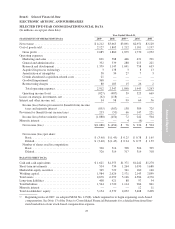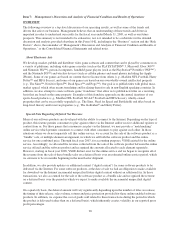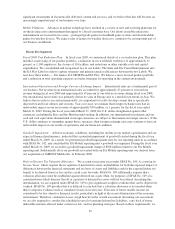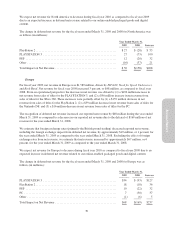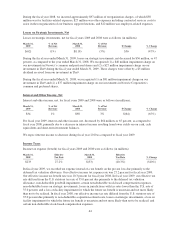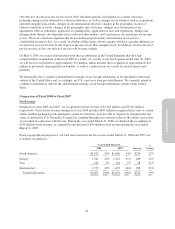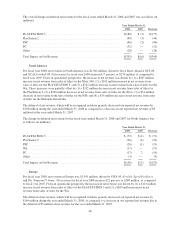Electronic Arts 2009 Annual Report Download - page 116
Download and view the complete annual report
Please find page 116 of the 2009 Electronic Arts annual report below. You can navigate through the pages in the report by either clicking on the pages listed below, or by using the keyword search tool below to find specific information within the annual report.Prepayments made to thinly capitalized independent software developers and co-publishing affiliates are
generally made in connection with the development of a particular product and, therefore, we are generally
subject to development risk prior to the release of the product. Accordingly, payments that are due prior to
completion of a product are generally expensed to research and development over the development period as the
services are incurred. Payments due after completion of the product (primarily royalty-based in nature) are
generally expensed as cost of goods sold.
Our contracts with some licensors include minimum guaranteed royalty payments which are initially recorded as
an asset and as a liability at the contractual amount when no performance remains with the licensor. When
performance remains with the licensor, we record guarantee payments as an asset when actually paid and as a
liability when incurred, rather than recording the asset and liability upon execution of the contract. These
obligations are classified as current liabilities to the extent such royalty payments are contractually due within the
next twelve months. As of March 31, 2009 and 2008, approximately $37 million and $10 million, respectively, of
minimum guaranteed royalty obligations had been recognized.
Each quarter, we also evaluate the future realization of our royalty-based assets, as well as any unrecognized
minimum commitments not yet paid to determine amounts we deem unlikely to be realized through product
sales. Any impairments or losses determined before the launch of a product are charged to research and
development expense. Impairments or losses determined post-launch are charged to cost of goods sold. We
evaluate long-lived royalty-based assets for impairment based on the provisions of SFAS No. 144 (i.e.,onan
undiscounted cash flow basis when impairment indicators exist). Unrecognized minimum royalty-based
commitments are accounted for as executory contracts and, therefore, any losses on these commitments are
recognized when the underlying intellectual property is abandoned (i.e., cease use) or the contractual rights to use
the intellectual property are terminated consistent with the provisions of SFAS No. 146, Accounting for Costs
Associated with Exit or Disposal Activities. During fiscal years 2009 and 2008, we recognized loss charges of
$43 million and loss and impairment charges of $4 million, respectively, related to our royalty agreements. We
had no loss or impairment charges during fiscal year 2007.
Income Taxes
We account for income taxes under SFAS No. 109, which requires the recognition of deferred tax assets and
liabilities for both the expected impact of differences between the financial statements and tax basis of assets and
liabilities and for the expected future tax benefit to be derived from tax loss and tax credit carry forwards. SFAS
No. 109 additionally requires that a valuation allowance must be established against deferred tax assets when, for
purposes of SFAS No. 109, it is considered more likely than not that all or a portion of deferred tax assets will
not be realized. In making this determination, we are required under SFAS No. 109 to give significant weight to
evidence that can be objectively verified. SFAS No. 109 provides that it is difficult to conclude that a valuation
allowance is not needed when there is negative evidence such as cumulative losses in recent years. Forecasts of
future taxable income are considered to be less objective than past results, particularly in light of the recent
deterioration of the economic environment. Therefore, cumulative losses weigh heavily in the overall assessment.
In addition to considering forecasts of future taxable income, we are also required to evaluate and quantify other
possible sources of taxable income in order to assess the realization of our deferred tax assets, namely the
reversal of existing deferred tax liabilities, the carry back of losses and credits as allowed under current tax law,
and the implementation of tax planning strategies. Evaluating and quantifying these amounts involves significant
judgments. Each source of income must be evaluated based on all positive and negative evidence, and involve
assumptions about future activity. SFAS No. 109 provides that certain taxable temporary differences that are not
expected to reverse during the carry forward periods permitted by tax law cannot be considered as a source of
future taxable income that may be available to realize the benefit of deferred tax assets. For example, when
determining the valuation allowance we recorded in the fiscal year ended March 31, 2009, we did not include as
a source of future taxable income the accumulated tax depreciation on our headquarters facilities in Redwood
City, California. These facilities are subject to leases which expire in July 2009, and are accounted for as
operating leases in accordance with SFAS No. 13, Accounting for Leases. If we are unable or decide not to renew
these leases and instead acquire the facilities, then we would be able to include a significant portion of the
36



